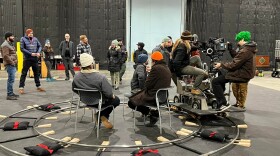It’s just two words, a small change. “Ladies” and “Gents” becomes “Larks” and "Robins.” But with these two words, folk dancers in Seattle have upended centuries of tradition, sparked a difficult debate, and changed their communities for the better.
Contra dancing originated in 16th and 17th-century English and French court and country dances and is still danced today across the U.S. and Canada, in some ways little changed. If you learned square dancing in elementary school, you’ll know the basics. Sets of couples spin and twirl through dance steps (“Do-si-do,” “Promenade”) with helpful instructions from a “caller” who calls out the upcoming steps and movements from the stage.
Contra dances are danced in two long lines and keep each dancer moving and trading dance partners without stopping. Contra dancing is fun, aerobic, a great way to make new friends. Twice a week in Seattle, you can find people contra dancing to folk musicians pulling from a variety of traditional music genres, everything from Appalachian to Celtic fiddling.
For centuries, contra dancing focused on the interactions between a man or “gent,” who leads a dance, and a woman or “lady,” who follows. “Ladies chain across and back” goes one traditional dance call. These uncompromising gender roles brought a lot of baggage. There were never enough men to fill out a line, and dancers were forced to dance to what others perceived as their gender.
For kids especially, the stiff gender roles were daunting. “If you have a group of kids, do you really want to introduce ‘Gents’ and ‘Ladies’?”’ asked Seattle contra dance caller Lindsey Dono (who uses she/they pronouns). “Your 13-year-old son is never going to come back to dancing.”
Dancers wanting to dance other roles or to dance with same-sex partners were often physically pushed into dancing a role they didn’t want.
In 2018, Dono organized the Next Gen Contra Dance Camp for younger musicians, dancers, and callers to address some of these issues. They aimed to “evolve the tradition,” making the dance more accessible and inclusive.
Other dances in the U.S. grappling with this had developed a new kind of gender neutral dance calling that replaced “ladies” and “gents” with “larks” and “robins.” Larks and robins removed the formal gender division and made the dance easier for beginners too: “lark” and “robin” corresponds to “left” and “right” on the dance floor which makes it easier to quickly identify your incoming dance partner.
Taking the new calls for a spin
Sherry Nevins has been dancing and calling contras in Seattle since 1979, and now leads the weekly Thursday night Lake City Contra Dance in the North end. She was the second oldest person at the Nex Gen camp, she remembered, but she wanted to support the younger generation and saw the potential for gender neutral calling.
Nevins began implementing gender neutral dances once a month at Lake City until late 2019 when the dance fully flipped over and continues to this day as exclusively gender neutral. Seattle’s other weekly dance, Emerald City, is also gender neutral.
This change wasn’t without controversy.
“When we did that first test dance," Nevins said. “A lot of dancers were stuck on ‘Why do we need different words? These are the traditional words. We're accepting anybody who wants to dance in whichever role. So why is it a problem?’”

For Northwest contra dance musician Alex Sturbaum, who uses they/them pronouns, it’s not a question of acceptance but a question of safety and comfort for everyone.
“If a community has made the choice to accept gender neutral calling and do the hard conversations and stuff that comes along with that transition,” they explained. “Then I'm going to guess that they also have considered what happens if somebody is behaving inappropriately on the dance floor. They are at least talking about how to improve the community experience for everybody and make it a safe and welcoming place.”
Sturbaum chose to come out as nonbinary after the pandemic in part because of these changes in the Northwest’s contra dance community.
“It wasn't like I came into the scene as a nonbinary individual and they made me feel welcome,” they explained. “It was knowing that there was this scene that would be so welcoming that partly gave me the courage to come out and publicly transition.”
Sturbaum plays in beloved contra dance band Countercurrent, in addition to nearly 20 other contra dance bands. They’ve taken the hard line of refusing to play for dances that use gendered calling, as has Dono, who won’t call these dances either.
Seattle trans fiddler and contra dance musician Hayden Stern, prefers to play for gender neutral dances but will also play for more “traditional” gendered contra dances. He came out as trans at a young age in a conservative area.
“I feel like it's more important for a more conservative community to encounter someone like me,” he said.
“I would rather visit those pockets and make sure people know that people like me exist and live really good lives.”
Stern and Sturbaum are currently working on the debut TransTrad Festival, coming June 6-8 in Olympia. Featuring all trans and nonbinary artists, the festival is one of the very few trans music festivals in the U.S. and will feature contra and square dances, plus concerts and workshops.
They both came up with the idea for the festival after Trump’s re-election, amidst fears of his plans to discriminate against trans people. Still, Stern said it’s not “a super trans-specific" event.
"Our goal is to just make a really dope music space that everyone's welcome in, where people also have to reckon with how much of our really excellent talent is trans and is part of a population that's really vulnerable right now,” he said.
Partnering with a new generation of contra dancers
On a clear, starry night in April, I make my way to the Latvian Center for the Lake City contra dance with my teenage daughter and her friends. She grew up in the tradition, falling asleep underneath the keyboard at contra dances our family band was playing. I, however, haven’t danced a contra dance since well before the change to gender neutral calling, so I feel like Rip Van Winkle.
In the early 2010s, the Lake City contra dance was known to be the older, more conservative dance, a sometimes sparsely attended place. Now the dance is probably 50/50 young dancers and older folks. The hall is packed and the energy is electric.
It takes me time to adjust to the new roles, but my daughter and her friends have never known anything but gender neutral dancing. They love the sense of freedom it gives them. One friend wouldn’t feel comfortable without it.
“ It feels like it sets a tone, like deliberately not using gendered language,” he said. He prefers to dance as the robin since he loves to twirl, and he’s noticed that while dancers like to specialize in one of the roles, that’s not tied to their gender.
Dancers are now switching roles at will; some of the most talented dancers will even switch roles during the dance. For my daughter, her wrist is hurting so tonight the robin role is easiest for her. As Nevins points out, being able to switch roles helps dancers, especially older dancers, compensate for any injuries.
Ultimately, what’s surprising is not that a community came together to make their space more welcoming for a younger generation of dancers. A group that has a much higher percentage of queer representation, according to a 2024 Country Dance & Song Society survey.
What’s surprising is that doing this has transformed the community for the better. Attendance is way up, a new generation of dancers is bringing a wonderful energy to the dance floor, and experienced older dancers can expand on their skill sets in new ways.
For Nevins, even though the change to gender neutral calling cost her dance a few dancers and callers who couldn’t get on board, ultimately this was about love and communication.
“If you're a community that doesn't communicate with each other,” she explained. “That sort of means that you don't care about each other, and we do care about each other.”







